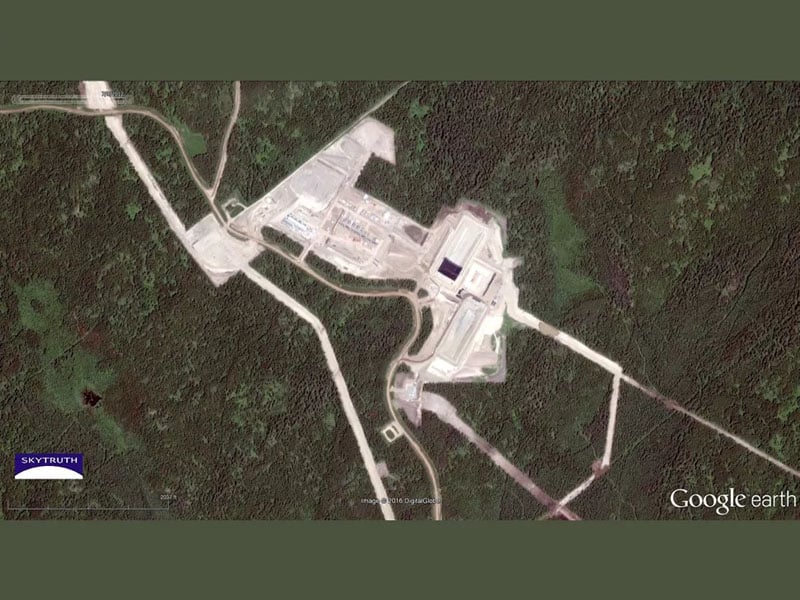Recent studies on hydraulic fracturing suggest the technology is causing more earthquakes than expected and that it doesn’t take the injection of much fluid to trigger a tremor.
In addition, researchers warn that the industry’s increasing reliance on “supersized” fracking using massive volumes of fluid and sand in longer wells could increase seismic hazards across North America.
A recent analysis of 300 hydraulically fractured wells near Fox Creek, Alberta, found that a modest injection of 10,000 cubic metres (2.6 million gallons) can cause an earthquake in geological formations containing faults.
The larger the volume of fluids injected underground, the greater the number of earthquakes, the study found.
“The rate of earthquake scales with the rising volume of injected fluids in sensitive areas,” said Gail Atkinson, one of the paper’s co-authors and a University of Western Ontario professor who holds a research chair in the hazards from induced seismicity.
“The more fluid you inject, the higher the productivity rate of earthquakes. It is almost like a dial,” she said. “It implies that you can affect the rate of earthquakes by changing the injected volume.”
But volume doesn’t seem to have any effect on the size of an earthquake that fluid injection might trigger if it hits a fault. In fact, no one can predict or model the potential severity of a tremor caused by oil and gas activities.
In fracking operations, energy companies inject high volumes of highly pressurized fluid, sand and chemicals underground to force open cracks in rock formations. The chaotic fractures, propped open by sand, allow hydrocarbons to flow.
In recent years the volume and pressure used in fracking operations has doubled or tripled in both Canada and the U.S.
A typical fracking operation in the Duvernay formation, which includes the area analyzed in the study, will inject more than 80,000 cubic metres, or nearly 17.6 million gallons of fluid and sand.
In Texas, the volume of sand used to prop open cracks in shale formations to release hydrocarbons has increased from 1,360 tonnes per well to 6,800 tonnes. In Canada, use has tripled from 3,000 tonnes per well to 12,000 tonnes.
At the same time companies such as Devon and Encana are experimenting with “supersized” fracking operations called “cube development” in the Permian shale formation in the eastern U.S. and the Montney Basin in B.C.
These deploy more force, sand and fluid by simultaneously drilling up to 24 wells into multiple levels of a shale formation. The process involves injection of fluids over an area more than a kilometre deep and several kilometres wide, targeting multiple depths.
“The total fluid volume is probably going to be very high with these cube developments and that means the potential for triggering a number of earthquakes could be large if faults are active in the area,” warned Atkinson.
The Canadian study found a “a statistically-significant correlation” between earthquakes and well pads in Fox Creek “with larger cumulative injected volume.”
The injected fluid must contact a fault which “can be located anywhere” under the surface, said Atkinson.
Since 2013 hydraulic fracturing has triggered hundreds of earthquakes in one part of the Duvernay formation near Fox Creek.
A series of micro-earthquakes in 2013 evolved into higher magnitude earthquakes three years later, peaking with a 4.8 magnitude event in 2016 that alarmed the citizens of Fox Creek and made scientific headlines.
The technology has also caused swarms of earthquakes in Ohio, England, Arkansas, Texas, Oklahoma and northeastern B.C., where fracking has entirely changed seismic patterns in the region.
Between 2014 and 2015, Malaysian-owned Progress Energy triggered almost 700 earthquakes in northeastern B.C., including a 4.6 magnitude tremor that could be felt almost 180 kilometres from the epicentre. It was caused by the injection of more than 160,000 cubic metres of water, chemicals and sand over a three-week period in 132 stages.
Industry-made earthquakes have raised serious concerns about public safety, gas migration and groundwater contamination.
Meanwhile researchers at Stanford University are warning that tiny tremors at fracking operations could be indicators of bigger quakes to come and “may act like canaries in a coal mine.”
In a retrospective analysis of earthquakes in Arkansas between 2010 and 2011 that ended with a magnitude 4 quake, researchers found that fracking, and not wastewater injection, set off more than 14,000 previously undetected earthquakes.
“We were particularly surprised by the size and persistence of the seismicity,” said William Ellsworth, a professor of geophysics at Stanford’s School of Earth, Energy & Environmental Sciences in a press release.
“When earthquakes during fracking operations are larger than expected and persist for weeks, it indicates a high level of stress in that area. Faults under high stress are unstable and can slip, triggering larger earthquakes.”
Researchers have known for more than 50 years that high volume fluid injection can induce significant earthquakes but oil and gas regulators have largely ignored the evidence. The U.S. Army caused a swarm of earthquakes while trying to dispose of toxic chemical waste outside of Denver, Colorado in the 1960s.
A 1990 report by the U.S. Geological Survey titled “Earthquake Hazard Associated with Deep Well Injection” documented a variety of incidents caused by fluid injection of waste water and hydraulic fracturing and implicated high volume injection as a critical issue near fault zones.
The report also noted that “the first and largest known Canadian example of an earthquake induced by fluid injection” (a 5.1 magnitude quake) occurred in Snipe Lake, northwest of Edmonton, in 1970.
In the 1960s the Texas oil industry triggered hundreds of earthquakes in the Permian basin while trying to coax out more oil by flooding reservoirs with water.
That region, now the subject of intensive, high-volume fracking for oil, was just mapped by Stanford researchers in an attempt to learn how to prevent the same kind of seismic hazards now plaguing Oklahoma and other regions.
Despite widespread industry claims that hydraulic fracturing couldn’t cause “felt” earthquakes, the U.S. researchers documented a different history in the field.
In 1977 and 1978 a “massive hydraulic fracturing program” in Oklahoma triggered scores of earthquakes. At least two of the quakes were “felt” at the surface.
The researchers wrote that small earthquakes signal the risk of larger and more damaging earthquakes. “The occurrence of any earthquakes, even as small as magnitude 0, near the bottom of a well should be viewed with concern,” they warned.
New studies also indicate that once industry has started earthquakes, turning them off can unpredictable.
According to a new study by scientists at Southern Methodist University, earthquakes continued to rumble beneath Dallas-Fort Worth International Airport for seven years after an oil and gas company shut a nearby wastewater injection well.
“Faults are not like a light switch — you don’t turn off a well and automatically stop triggering earthquakes,” said Heather DeShon, a seismologist at Southern Methodist University and co-author of the paper.
Reducing seismic hazards has become a major concern in Oklahoma where regulators reluctantly forced operators to reduce the volume of fluids being injected into the ground after industry triggered “an approximately 800-fold increase in the annual number of earthquakes” in that state beginning in 2011.
Significant reductions in 2015 initially reduced the number of smaller earthquakes, but did not put a damper on earthquakes of magnitude 3 or greater. In fact two significant magnitude 5 earthquakes shook the state in 2016. One threatened the world’s largest oil storage facility where 14 pipelines converge and more than 40 million barrels of oil and Canadian bitumen are stored.
Deemed “critical infrastructure” by the U.S. government, the huge storage oil tank farm was designed to withstand tornados — but not man-made earthquakes.
The message for regulators is clear, said Atkinson.
“They should exercise caution where licences to fracking operations are given out. Don’t do it in areas where the consequences of large induced earthquakes might be unacceptable to critical infrastructure.” ![]()
Read more: Energy, BC Politics, Environment

















Tyee Commenting Guidelines
Comments that violate guidelines risk being deleted, and violations may result in a temporary or permanent user ban. Maintain the spirit of good conversation to stay in the discussion.
*Please note The Tyee is not a forum for spreading misinformation about COVID-19, denying its existence or minimizing its risk to public health.
Do:
Do not: